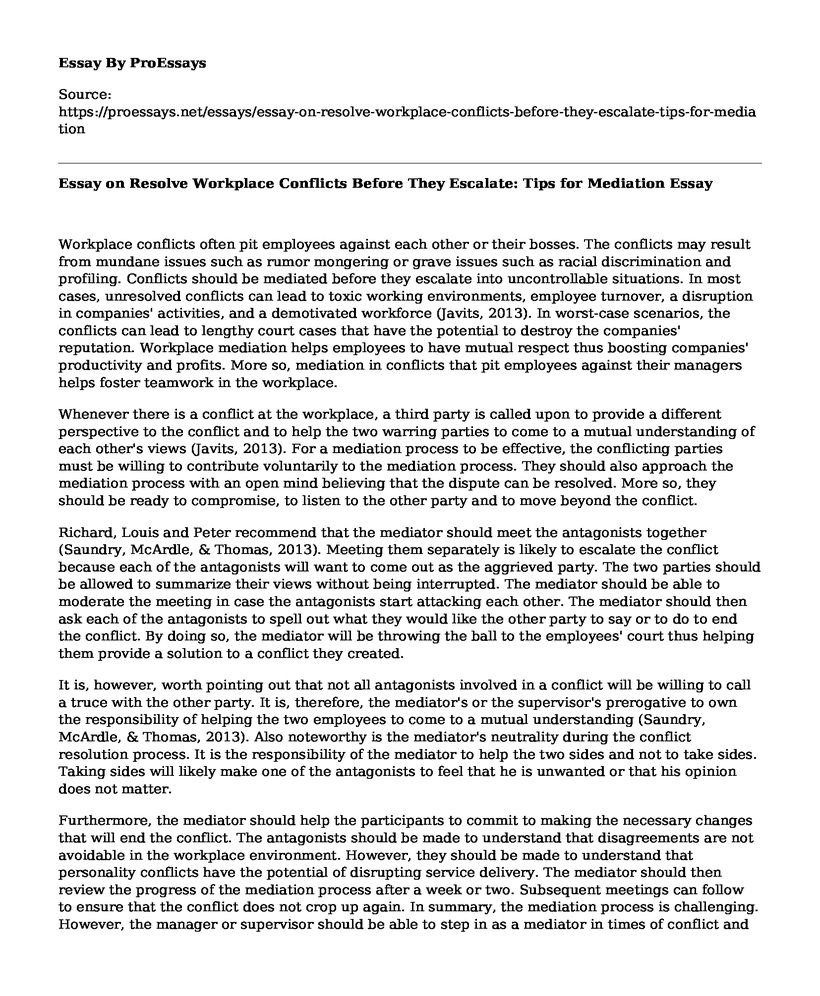Workplace conflicts often pit employees against each other or their bosses. The conflicts may result from mundane issues such as rumor mongering or grave issues such as racial discrimination and profiling. Conflicts should be mediated before they escalate into uncontrollable situations. In most cases, unresolved conflicts can lead to toxic working environments, employee turnover, a disruption in companies' activities, and a demotivated workforce (Javits, 2013). In worst-case scenarios, the conflicts can lead to lengthy court cases that have the potential to destroy the companies' reputation. Workplace mediation helps employees to have mutual respect thus boosting companies' productivity and profits. More so, mediation in conflicts that pit employees against their managers helps foster teamwork in the workplace.
Whenever there is a conflict at the workplace, a third party is called upon to provide a different perspective to the conflict and to help the two warring parties to come to a mutual understanding of each other's views (Javits, 2013). For a mediation process to be effective, the conflicting parties must be willing to contribute voluntarily to the mediation process. They should also approach the mediation process with an open mind believing that the dispute can be resolved. More so, they should be ready to compromise, to listen to the other party and to move beyond the conflict.
Richard, Louis and Peter recommend that the mediator should meet the antagonists together (Saundry, McArdle, & Thomas, 2013). Meeting them separately is likely to escalate the conflict because each of the antagonists will want to come out as the aggrieved party. The two parties should be allowed to summarize their views without being interrupted. The mediator should be able to moderate the meeting in case the antagonists start attacking each other. The mediator should then ask each of the antagonists to spell out what they would like the other party to say or to do to end the conflict. By doing so, the mediator will be throwing the ball to the employees' court thus helping them provide a solution to a conflict they created.
It is, however, worth pointing out that not all antagonists involved in a conflict will be willing to call a truce with the other party. It is, therefore, the mediator's or the supervisor's prerogative to own the responsibility of helping the two employees to come to a mutual understanding (Saundry, McArdle, & Thomas, 2013). Also noteworthy is the mediator's neutrality during the conflict resolution process. It is the responsibility of the mediator to help the two sides and not to take sides. Taking sides will likely make one of the antagonists to feel that he is unwanted or that his opinion does not matter.
Furthermore, the mediator should help the participants to commit to making the necessary changes that will end the conflict. The antagonists should be made to understand that disagreements are not avoidable in the workplace environment. However, they should be made to understand that personality conflicts have the potential of disrupting service delivery. The mediator should then review the progress of the mediation process after a week or two. Subsequent meetings can follow to ensure that the conflict does not crop up again. In summary, the mediation process is challenging. However, the manager or supervisor should be able to step in as a mediator in times of conflict and diffuse the tension among employees.
References
Javits, J. M. (2013). Internal Conflict Resolution at International Organizations. ABA Journal of Labor & Employment Law, 28(2), 223-253.
Saundry, R., McArdle, L., & Thomas, P. (2013). Reframing workplace relations? Conflict resolution and mediation in a primary care trust. Work, Employment & Society, 27(2), 213-231.
Cite this page
Essay on Resolve Workplace Conflicts Before They Escalate: Tips for Mediation. (2022, Dec 27). Retrieved from https://proessays.net/essays/essay-on-resolve-workplace-conflicts-before-they-escalate-tips-for-mediation
If you are the original author of this essay and no longer wish to have it published on the ProEssays website, please click below to request its removal:
- Essay Sample on Women and Employment
- Get Out: Analysis of Interracial Relationship and Family Dynamics
- Essay on HFACS Application in Ameristar Air Cargo Runaway Overrun Accident
- Expectancy & Drive Theories: Exploring Motivation in Action - Essay Sample
- Motivation and Its Benefits/Drawbacks in Children: A Unit One Overview - Essay Sample
- Free Report on INTJ Personality Type: My Jung Test Results
- Free Paper on Bad Leaders: Celebrities & Music Makers Who Misuse Influence







